
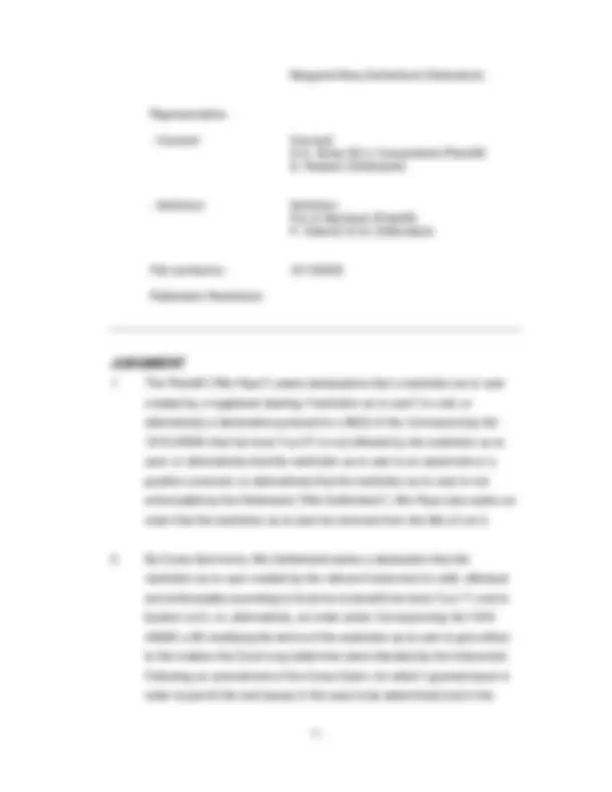
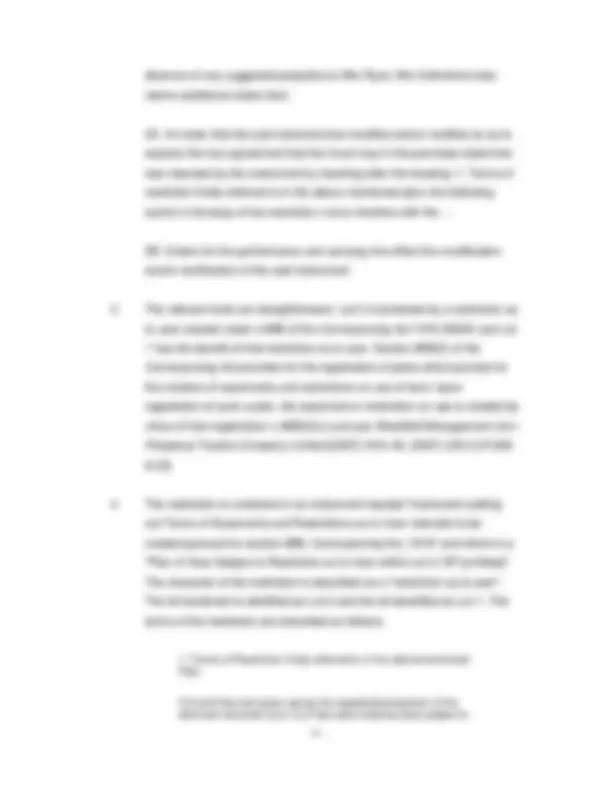
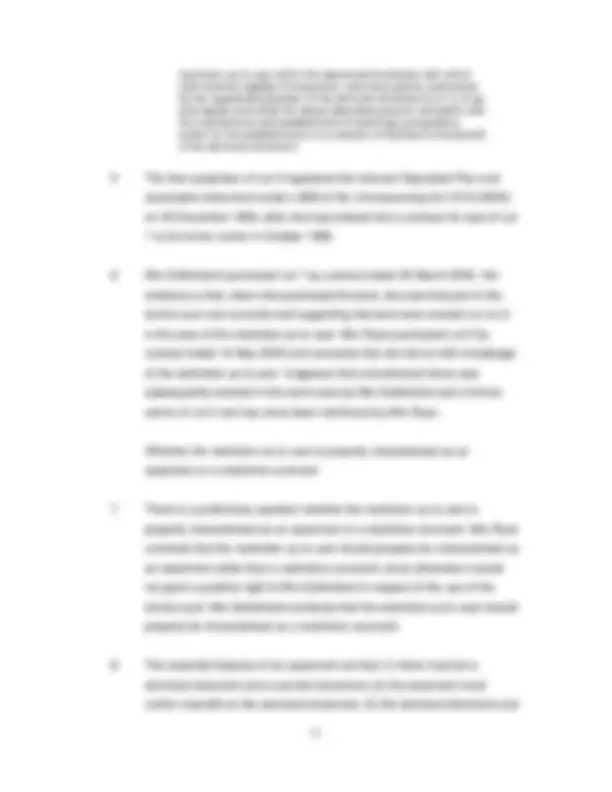
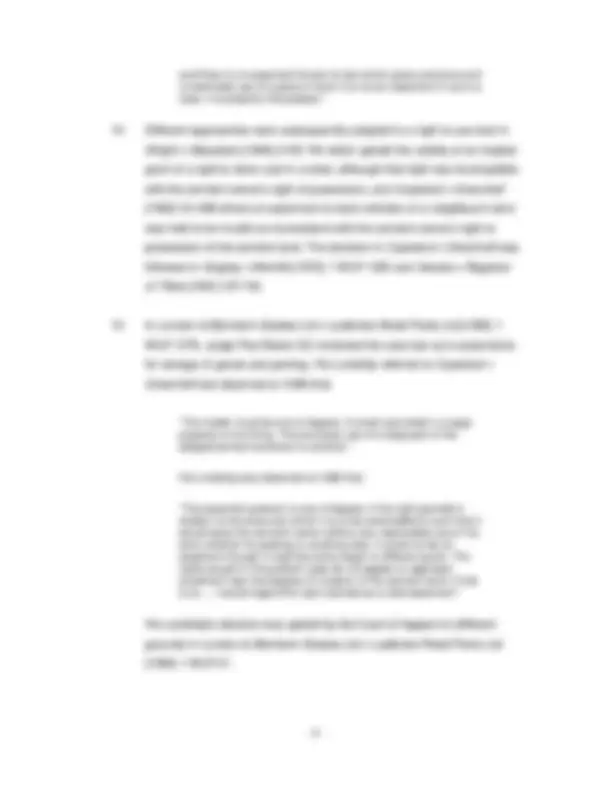
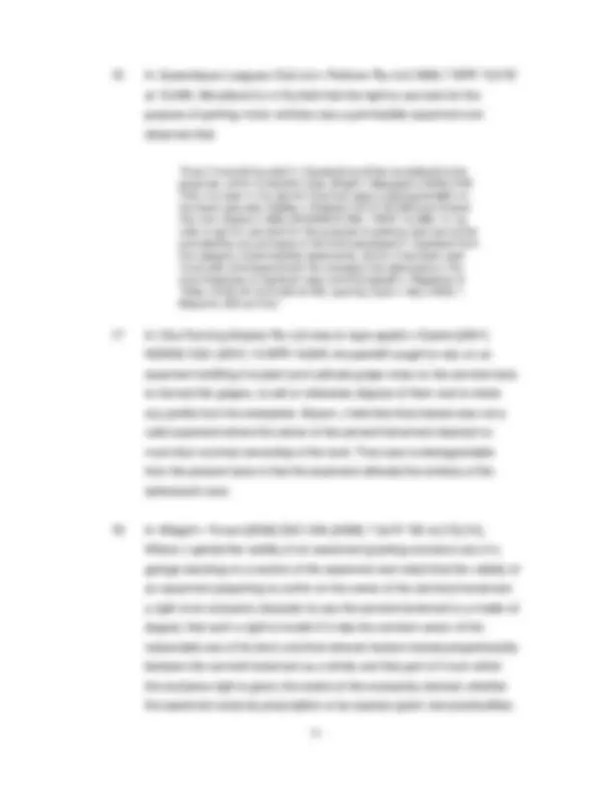
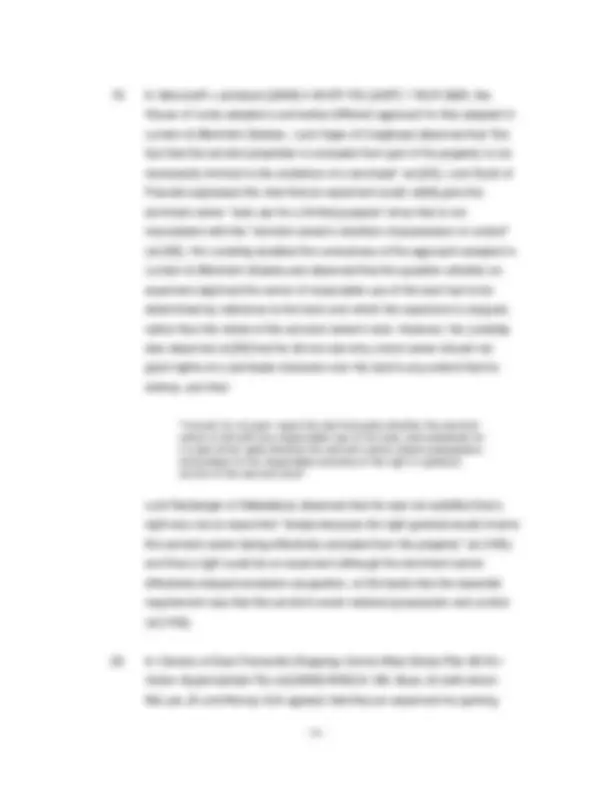
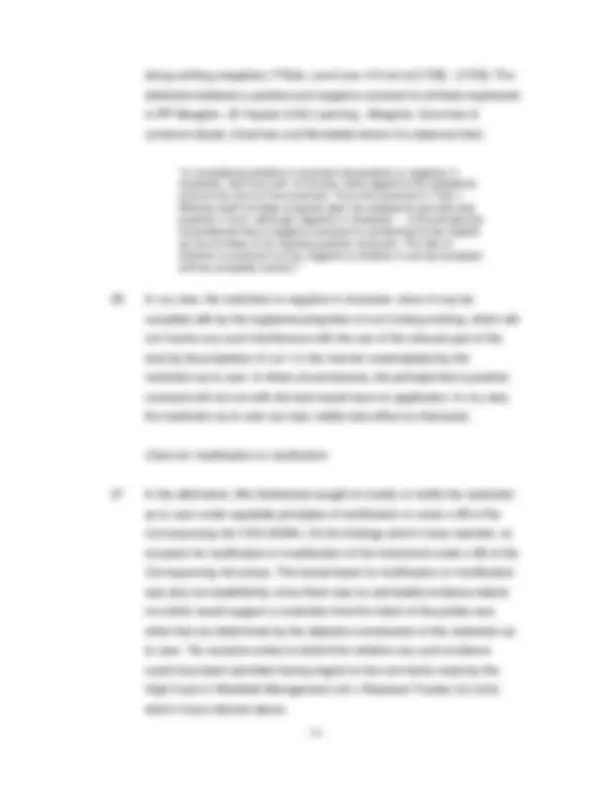
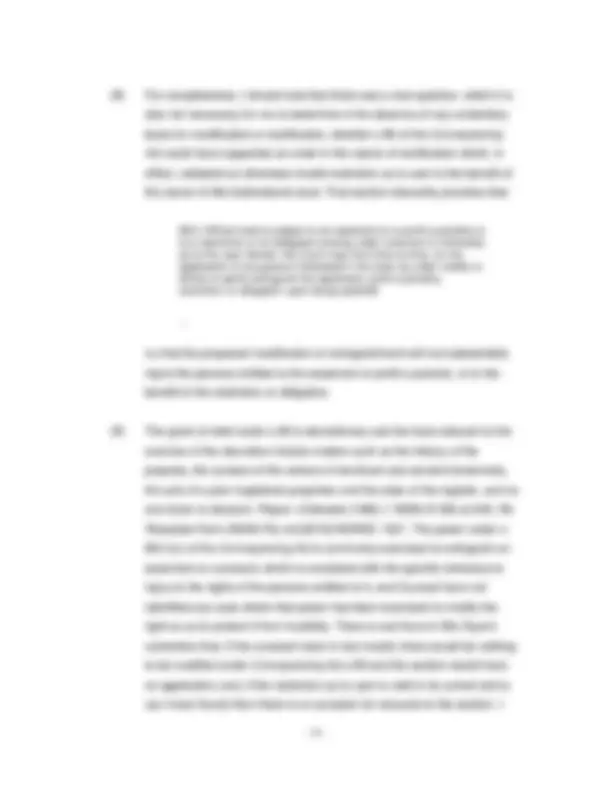
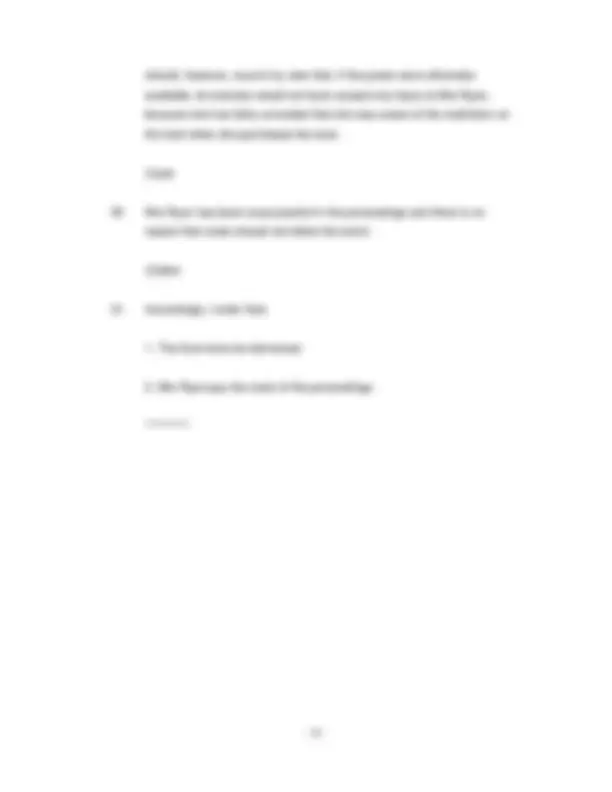


Study with the several resources on Docsity

Earn points by helping other students or get them with a premium plan


Prepare for your exams
Study with the several resources on Docsity

Earn points to download
Earn points by helping other students or get them with a premium plan
Community
Ask the community for help and clear up your study doubts
Discover the best universities in your country according to Docsity users
Free resources
Download our free guides on studying techniques, anxiety management strategies, and thesis advice from Docsity tutors
A legal case in which the validity of a restrictive covenant permitting recreational use on a piece of land is in question. the relevant legislation, including the Conveyancing Act 1919 (NSW), and the court's interpretation of the restriction as to user. The case considers whether the restriction should be characterized as an easement or a restrictive covenant and whether it is enforceable against a subsequent purchaser.
What you will learn
Typology: Study notes
1 / 15

This page cannot be seen from the preview
Don't miss anything!










Case Title: Adrienne Ryan v Margaret Mary Sutherland
Medium Neutral Citation: [2011] NSWSC 1397
Hearing Date(s): 31 October 2011
Decision Date: 22 November 2011
Jurisdiction:
Equity Division
Before: Black J
Decision: Summons dismissed - held that restriction as to user is valid and enforceable against subsequent purchaser of land
Catchwords: REAL PROPERTY - Easements - Restrictive covenants - Validity of restriction permitting use for recreational and other purposes
Legislation Cited: - Conveyancing Act 1919 (NSW) ss 88B, 88B(2), 88B(3)(c), 89, 89(1)(c), 89(3)
Cases Cited: - Berger Bros Trading Co Pty Ltd v Bursill Enterprises Pty Ltd (1969) 91 WN (NSW) 521
apptd) v Easton [2001] NSWSC 525; (2001) 10 BPR 18,
Texts Cited: - A Bradbrook & M Neave, Easements and Restrictive Covenants in Australia, 2nd ed
Category: Principal judgment
Parties: Adrienne Ryan (Plaintiff)
absence of any suggested prejudice to Mrs Ryan, Mrs Sutherland also claims additional orders that:
2A. An order that the said instrument be modified and/or rectified so as to express the true agreement that the Court may in the premises determine was intended by the instrument by inserting after the heading '1. Terms of restriction firstly referred to in the above mentioned plan; the following words in the body of the restriction; not to interfere with the ...
2B. Orders for the performance and carrying into effect the modification and/or rectification of the said instrument.
3 The relevant facts are straightforward. Lot 2 is burdened by a restriction as to user created under s 88B of the Conveyancing Act 1919 (NSW) and Lot 1 has the benefit of that restriction as to user. Section 88B(2) of the Conveyancing Act provides for the registration of plans which provide for the creation of easements and restrictions on use of land. Upon registration of such a plan, the easement or restriction on use is created by virtue of that registration: s 88B(3)(c) and see Westfield Management Ltd v Perpetual Trustee Company Limited [2007] HCA 45; (2007) 233 CLR 528 at [3].
4 The restriction is contained in an instrument headed "Instrument setting out Terms of Easements and Restrictions as to User intended to be created pursuant to section 88B, Conveyancing Act, 1919" and refers to a "Plan of Area Subject to Restriction as to User within Lot 2, DP [omitted]". The character of the restriction is described as a "restriction as to user". The lot burdened is identified as Lot 2 and the lot benefited as Lot 1. The terms of the restriction are described as follows:
Full and free exclusive use by the registered proprietor of the dominant tenement [Lot 1] of that area noted as area subject to
restriction as to user within the abovementioned plan with which right shall be capable of enjoyment, and every person authorised by the registered proprietor of the dominant tenement [Lot 1], to go and repass and utilise the above-described area for recreation and the maintenance and establishment of plantings and gardens and/or for the establishment of or erection of facilities to the benefit of the dominant tenement.
5 The then proprietor of Lot 2 registered the relevant Deposited Plan and associated instrument under s 88B of the Conveyancing Act 1919 (NSW) on 23 December 1996, after she had entered into a contract for sale of Lot 1 to its former owner in October 1996.
6 Mrs Sutherland purchased Lot 1 by contract dated 30 March 2000. Her evidence is that, when she purchased the land, she saw that part of the tennis court and concrete wall supporting that land were erected on Lot 2 in the area of the restriction as to user. Mrs Ryan purchased Lot 2 by contract dated 16 May 2005 and concedes that she did so with knowledge of the restriction as to user. It appears that a brushwood fence was subsequently erected in the same area by Mrs Sutherland and a former owner of Lot 2 and has since been reinforced by Mrs Ryan.
Whether the restriction as to user is properly characterised as an easement or a restrictive covenant
7 There is a preliminary question whether the restriction as to user is properly characterised as an easement or a restrictive covenant. Mrs Ryan contends that the restriction as to user should properly be characterised as an easement rather than a restrictive covenant, since otherwise it would not grant a positive right to Mrs Sutherland in respect of the use of the tennis court. Mrs Sutherland contends that the restriction as to user should properly be characterised as a restrictive covenant.
8 The essential features of an easement are that (1) there must be a dominant tenement and a servient tenement; (2) the easement must confer a benefit on the dominant tenement; (3) the dominant tenement and
11 There are some textual indications which would support a characterisation of the restriction as to user as a restrictive covenant, intended to be a promise as to the use of Lot 2, which would in turn confer a right on the owner of Lot 1. The paragraph setting out its terms appears under the underlined heading "Terms of Restriction firstly referred to in the abovementioned Plan". On the other hand, the terms of the instrument then refer to a right to full and free exclusive use by the registered proprietor of Lot 2 of the specified area for the specified purposes and do not expressly refer to a limitation on actions by the registered proprietor of Lot 1. In substance, it seems to me that the restriction as to user has each of the characteristics of an easement, benefits Lot 1 in the manner of an easement, and operates similarly to the rights of occupation which have been conferred by easement in several of the cases to which I refer below. On balance, I therefore consider that the restriction as to user is properly construed as an easement rather than a restrictive covenant.
12 However, the determination of the question whether the restriction as to user should be characterised as an easement or a restrictive covenant is ultimately not essential to the resolution of this matter, since the question in issue before me is the validity of the restriction as to user and I consider that it would be valid as either an easement or a restriction as to user for the reasons set out below.
Whether the restriction as to user is valid as an easement
13 Mrs Ryan contends that, when characterised as an easement, the restriction as to user would be invalid because an easement which gives exclusive and unrestricted use of a piece of land would not satisfy the fourth requirement noted in paragraph 8 above. Mrs Ryan relies on the principle set out in Reilly v Booth (1890) 44 Ch D 12 at 26, where Lopes LJ observed that:
"The exclusive or unrestricted use of a piece of land, I take it, beyond all question passes the property or ownership in that land,
and there is no easement known to law which gives exclusive and unrestricted use of a piece of land. It is not an easement in such a case, it is property that passes."
14 Different approaches were subsequently adopted to a right to use land in Wright v Macadam [1949] 2 KB 744 which upheld the validity of an implied grant of a right to store coal in a shed, although that right was incompatible with the servient owner's right of possession, and Copeland v Greenhalf [1952] Ch 488 where an easement to store vehicles on a neighbour's land was held to be invalid as inconsistent with the servient owner's right to possession of the servient land. The decision in Copeland v Greenhalf was followed in Grigsby v Melville [1972] 1 WLR 1355 and Harada v Registrar of Titles [1981] VR 743.
15 In London & Blenheim Estates Ltd v Ladbroke Retail Parks Ltd [1992] 1 WLR 1278, Judge Paul Baker QC reviewed the case law as to easements for storage of goods and parking. His Lordship referred to Copeland v Greenhalf and observed at 1286 that:
"The matter must be one of degree. A small coal shed in a large property is one thing. The exclusive use of a large part of the alleged servient tenement is another."
His Lordship also observed at 1288 that:
"The essential question is one of degree. If the right granted in relation to the area over which it is to be exercisable is such that it would leave the servient owner without any reasonable use of his land, whether for parking or anything else, it could not be an easement though it might be some larger or different grant. The rights sought in the present case do not appear to approach anywhere near that degree of invasion of the servient land. If that is so ... I would regard the right claimed as a valid easement."
His Lordship's decision was upheld by the Court of Appeal on different grounds in London & Blenheim Estates Ltd v Ladbroke Retail Parks Ltd [1994] 1 WLR 31.
19 In Moncrieff v Jamieson [2008] 4 All ER 752; [2007] 1 WLR 2620, the House of Lords adopted a somewhat different approach to that adopted in London & Blenheim Estates. Lord Hope of Craighead observed that "the fact that the servient proprietor is excluded from part of his property is not necessarily inimical to the existence of a servitude" (at [24]). Lord Scott of Foscote expressed the view that an easement could validly give the dominant owner "sole use for a limited purpose" since that is not inconsistent with the "servient owner's retention of possession or control" (at [55]). His Lordship doubted the correctness of the approach adopted in London & Blenheim Estates and observed that the question whether an easement deprived the owner of reasonable use of the land had to be determined by reference to the land over which the easement is enjoyed, rather than the whole of the servient owner's land. However, his Lordship also observed at [59] that he did not see why a land owner should not grant rights of a servitudal character over his land to any extent that he wishes, and that:
"I would, for my part, reject the test that asks whether the servient owner is left with any reasonable use of his land, and substitute for it a test which asks whether the servient owner retains possession, and subject to the reasonable exercise of the right in question, control of the servient land."
Lord Neuberger of Abbotsbury observed that he was not satisfied that a right was not an easement "simply because the right granted would involve the servient owner being effectively excluded from the property" (at [140]) and that a right could be an easement although the dominant owner effectively enjoyed exclusive occupation, on the basis that the essential requirement was that the servient owner retained possession and control (at [143]).
20 In Owners of East Fremantle Shopping Centre West Strata Plan 8618 v Action Supermarkets Pty Ltd [2008] WASCA 180, Buss JA (with whom McLure JA and Murray AJA agreed) held that an easement for parking
was a valid easement where it satisfied both the tests in London & Blenheim Estates and Moncrieff v Jamieson.
21 In Brydall Pty Ltd v Owners of Strata Plan 66794 [2009] NSWSC 819 at [15], McDougall J noted that the question whether an exclusive easement would deprive the owner of the servient land of the whole of the beneficial use of the parcel of land subject to the rights may not be a relevant consideration, for two reasons which his Honour identified as follows:
"One is that the test (referred in Copeland v Greenhalf [1952] Ch
22 In my view, the restriction as to user, if construed as an easement, would satisfy the test set out in London & Blenheim Estates , as applied to the whole of Lot 2 in accordance with the trend of the Australian cases to which McDougall J referred in Brydall Pty Ltd v Owners of Strata Plan 66794. It appears from inspection of the plans in evidence before me that the restriction as to user affects a relatively small part of Lot 2 and it does not (by contrast with the easement in Clos Farming Estates Pty Ltd (recs & mgrs apptd) v Easton ) confer exclusive or unrestricted use of the whole of Lot 2 on Mrs Sutherland. I do not think it could be said that the restriction as to user has the result that Mrs Ryan retains no more than nominal ownership of Lot 2 (in the language of Clos Farming Estates Pty Ltd (recs & mgrs apptd) v Easton ), so far as she continues to have possession and control of the house which occupies the larger part of that lot.
23 On balance, I also consider that the restriction as to user would also satisfy the alternative test set out in Moncrieff v Jamieson , referring to the part of
doing nothing (negative): P Butt, Land Law, 4 th ed at [1728] - [1729]. The distinction between a positive and negative covenant is similarly expressed in RP Meagher, JD Heydon & MJ Leeming , Meagher, Gummow & Lehane's Equity: Doctrines and Remedies where it is observed that:
"in considering whether a covenant be positive or negative in character, the Court will, of course, have regard to the substance and not the form of the covenant. Thus the covenant in Tulk v Moxhay itself (to keep a square open as a pleasure ground) was positive in form, although negative in character ... It should also be remembered that a negative covenant is sometimes to be implied as the corollary of an express positive covenant. The test of whether a covenant is truly negative is whether it can be complied with by complete inaction."
26 In my view, the restriction is negative in character, since it may be complied with by the registered proprietor of Lot 2 doing nothing, which will not involve any such interference with the use of the relevant part of the land by the proprietor of Lot 1 in the manner contemplated by the restriction as to user. In these circumstances, the principle that a positive covenant will not run with the land would have no application. In my view, the restriction as to user can also validly take effect on that basis.
Claim for modification or rectification
27 In the alternative, Mrs Sutherland sought to modify or rectify the restriction as to user under equitable principles of rectification or under s 89 of the Conveyancing Act 1919 (NSW). On the findings which I have reached, no occasion for rectification or modification of the instrument under s 89 of the Conveyancing Act arises. The factual basis for rectification or modification was also not established, since there was no admissible evidence before me which would support a contention that the intent of the parties was other than as determined by the objective construction of the restriction as to user. No occasion arises to determine whether any such evidence could have been admitted having regard to the comments made by the High Court in Westfield Management Ltd v Perpetual Trustee Co Ltd to which I have referred above.
28 For completeness, I should note that there was a real question, which it is also not necessary for me to determine in the absence of any evidentiary basis for modification or rectification, whether s 89 of the Conveyancing Act could have supported an order in the nature of rectification which, in effect, validated an otherwise invalid restriction as to user to the benefit of the owner of Mrs Sutherland's land. That section relevantly provides that:
89(1) Where land is subject to an easement or a profit a prendre or to a restriction or an obligation arising under covenant or otherwise as to the user thereof, the Court may from time to time, on the application of any person interested in the land, by order modify or wholly or partly extinguish the easement, profit a prendre, restriction or obligation upon being satisfied
...
(c) that the proposed modification or extinguishment will not substantially injure the persons entitled to the easement or profit a prendre, or to the benefit of the restriction or obligation.
29 The grant of relief under s 89 is discretionary and the facts relevant to the exercise of the discretion include matters such as the history of the property, the conduct of the owners of dominant and servient tenements, the acts of a prior registered proprietor and the state of the register, and no one factor is decisive: Pieper v Edwards (1982) 1 NSWLR 336 at 340; Re Rosedale Farm (NSW) Pty Ltd [2010] NSWSC 1321. The power under s 89(1)(c) of the Conveyancing Act is commonly exercised to extinguish an easement or covenant, which is consistent with the specific reference to injury to the rights of the persons entitled to it, and Counsel have not identified any case where that power has been exercised to modify the right so as to protect it from invalidity. There is real force in Mrs Ryan's contention that, if the covenant were in fact invalid, there would be nothing to be modified under Conveyancing Act s 89 and the section would have no application; and, if the restriction as to user is valid in its current terms (as I have found) then there is no occasion for recourse to the section. I